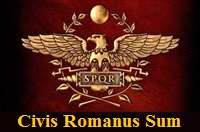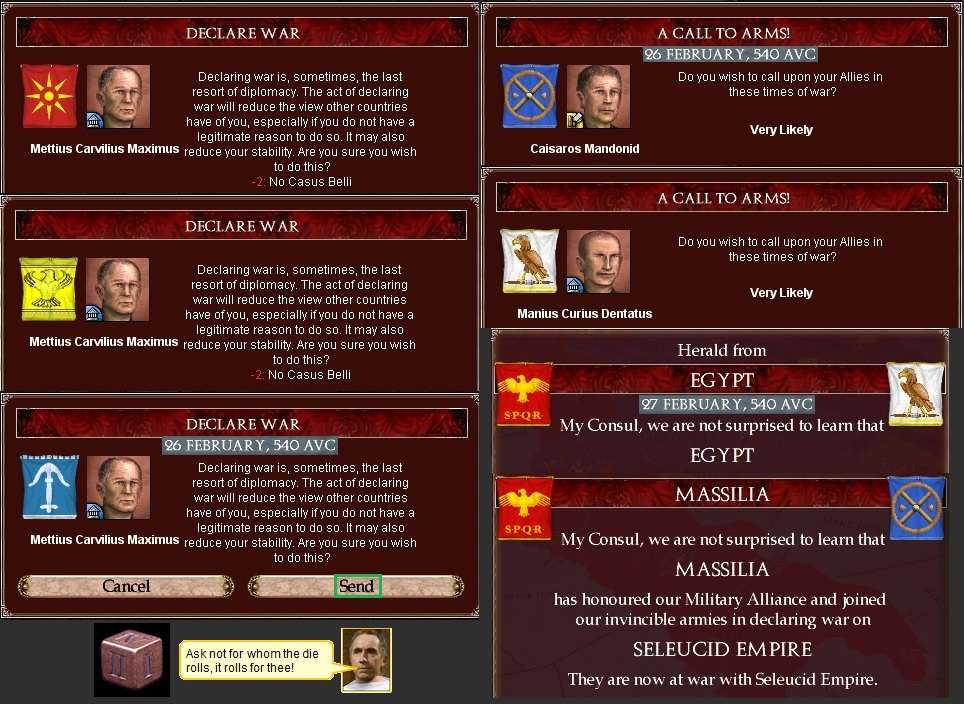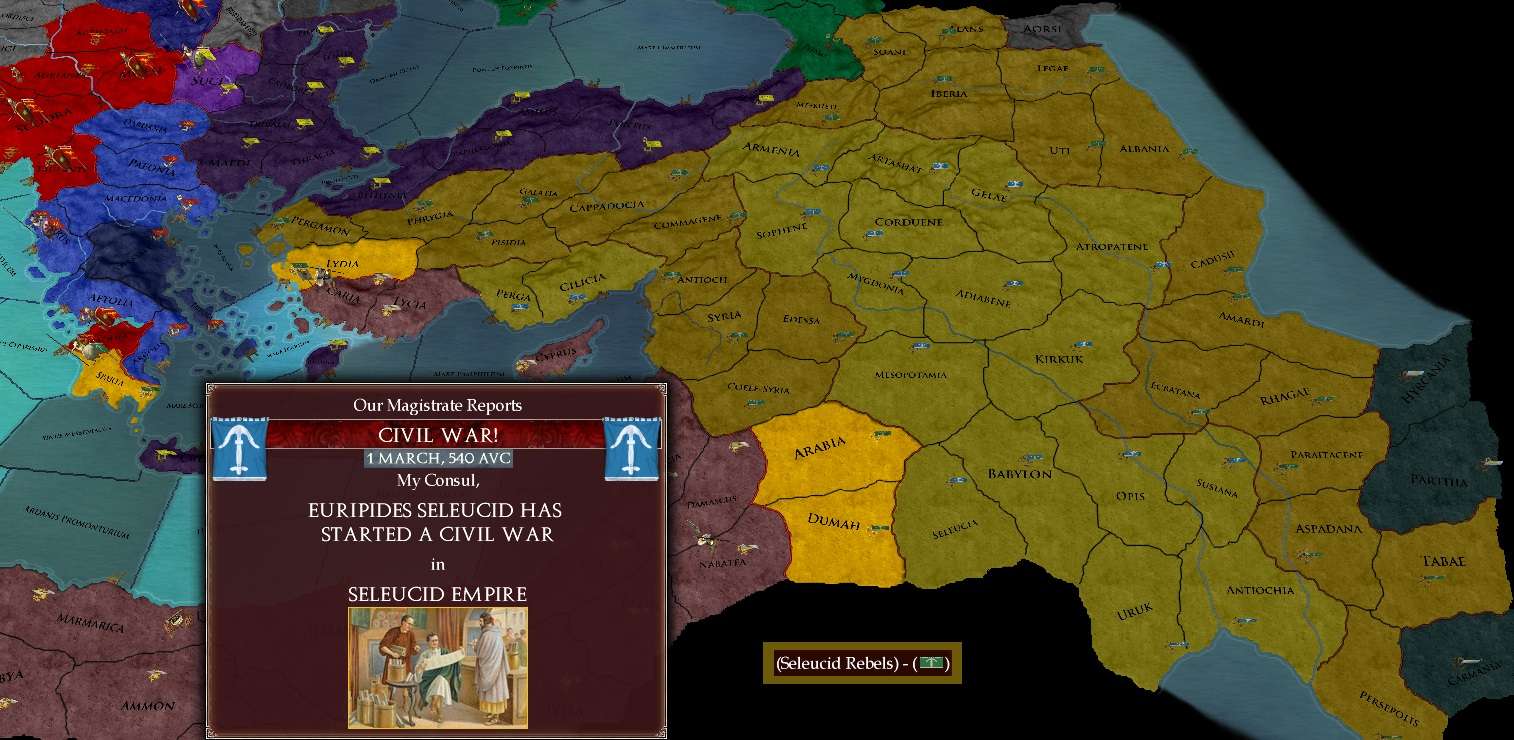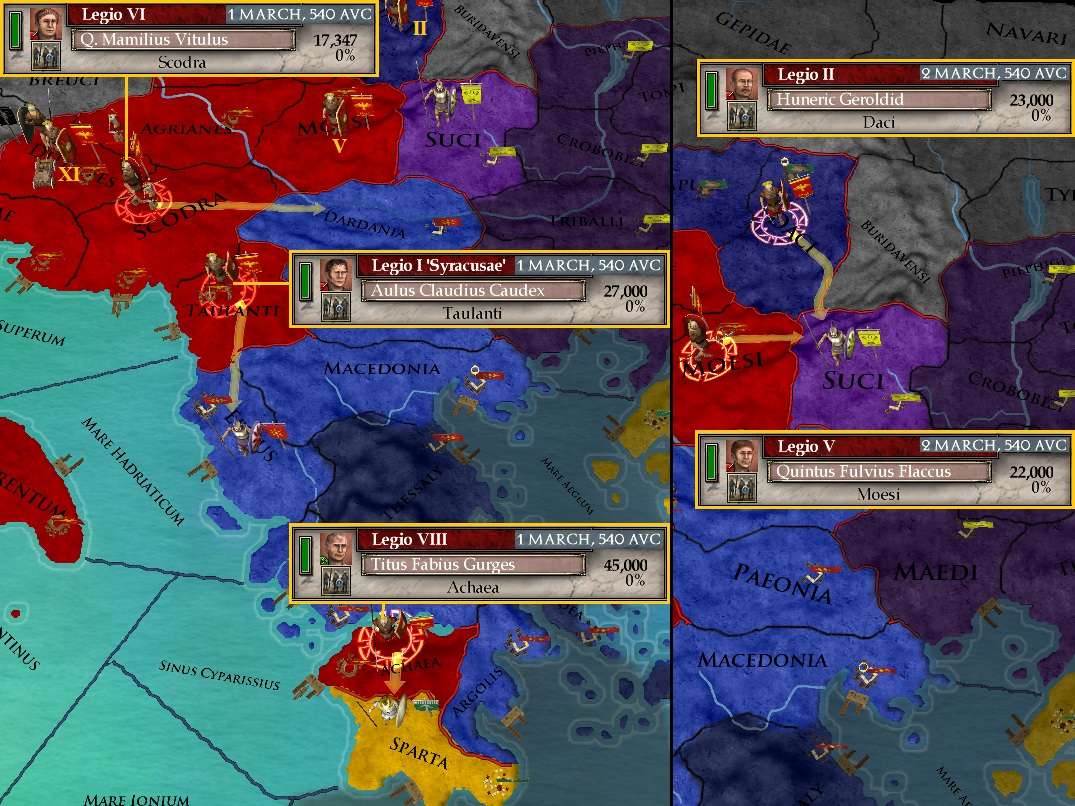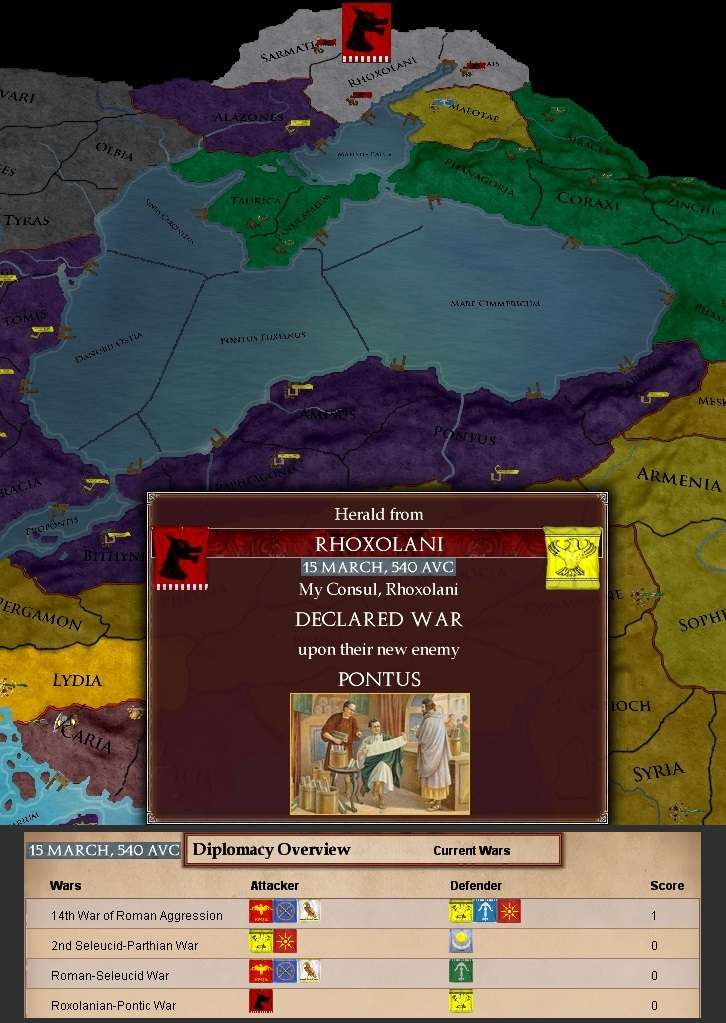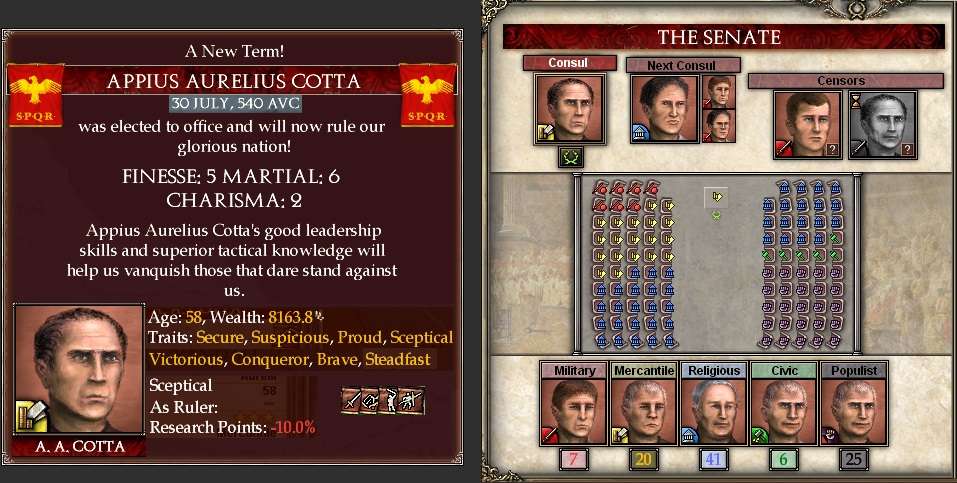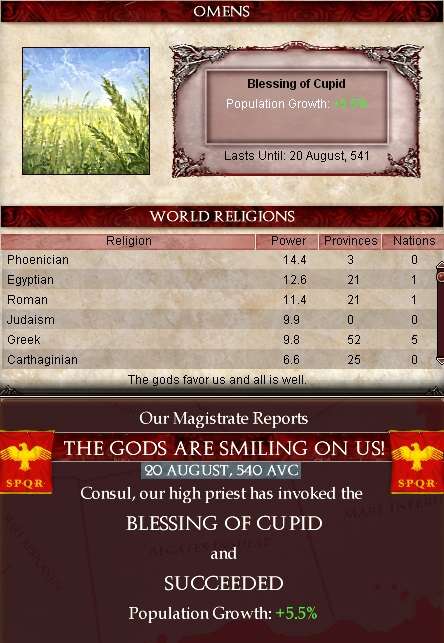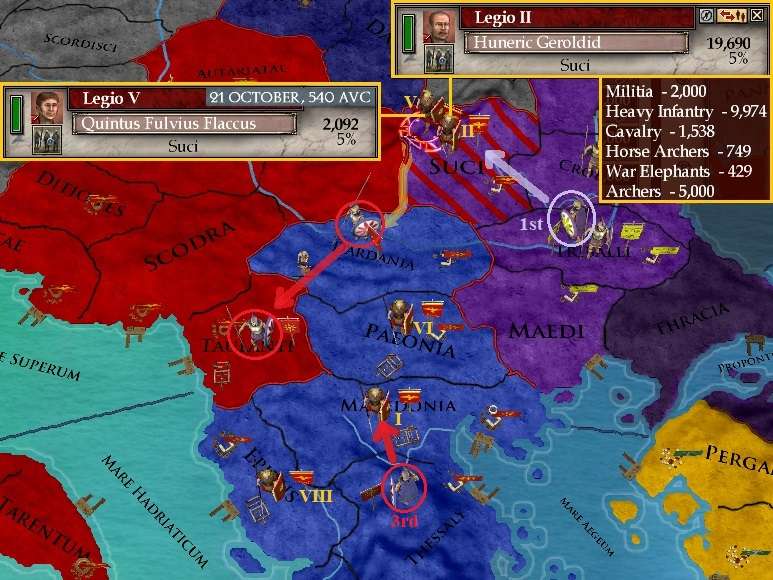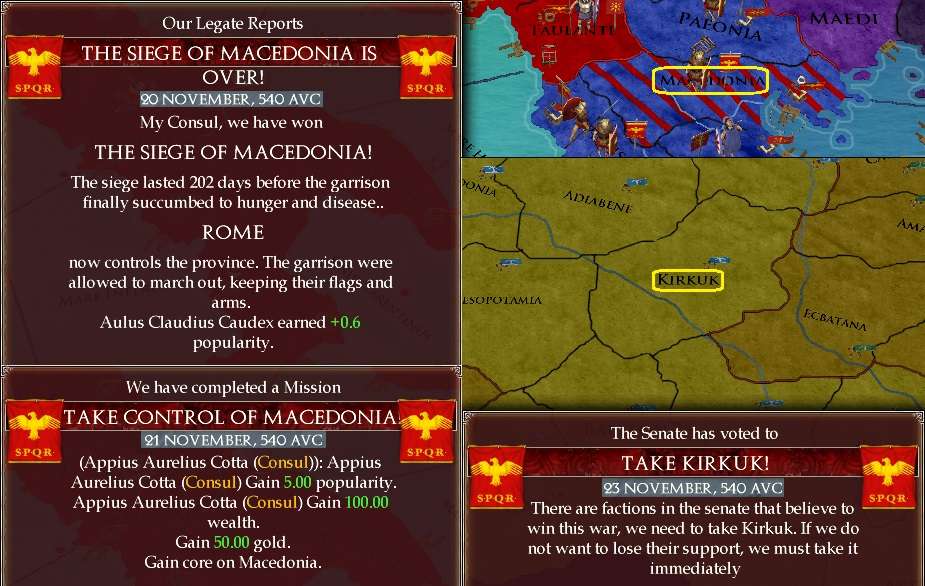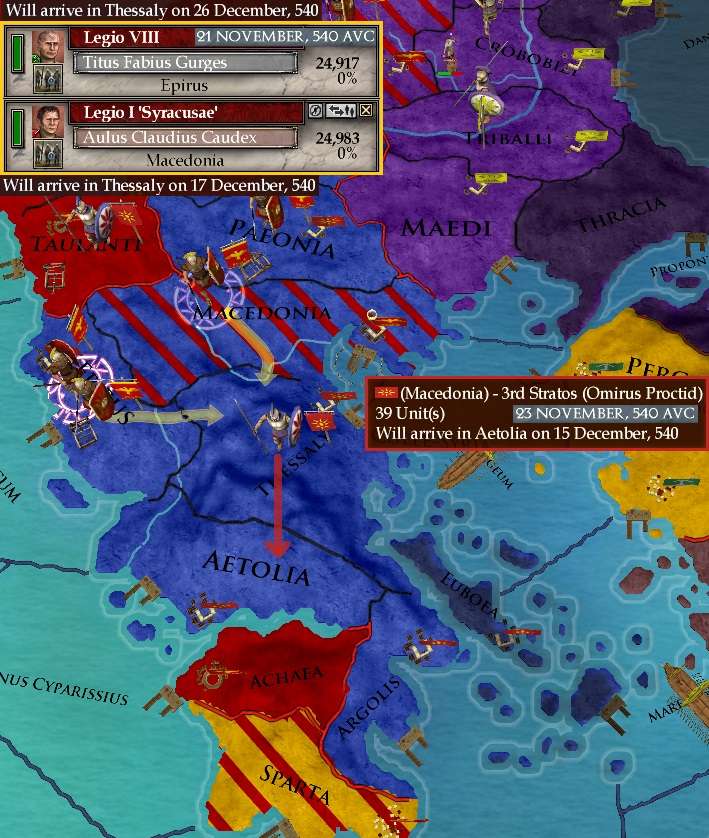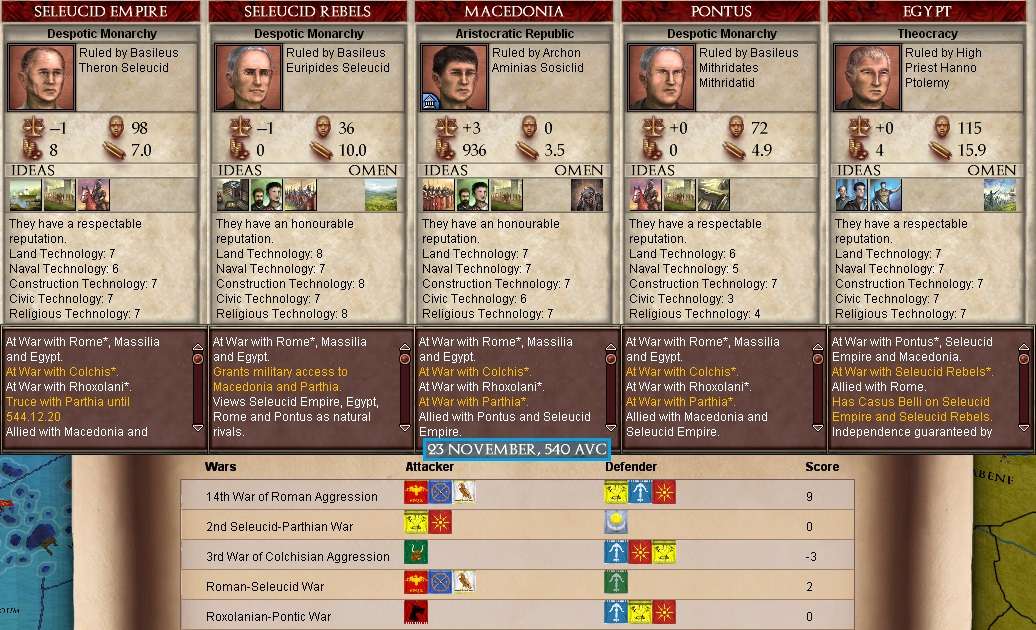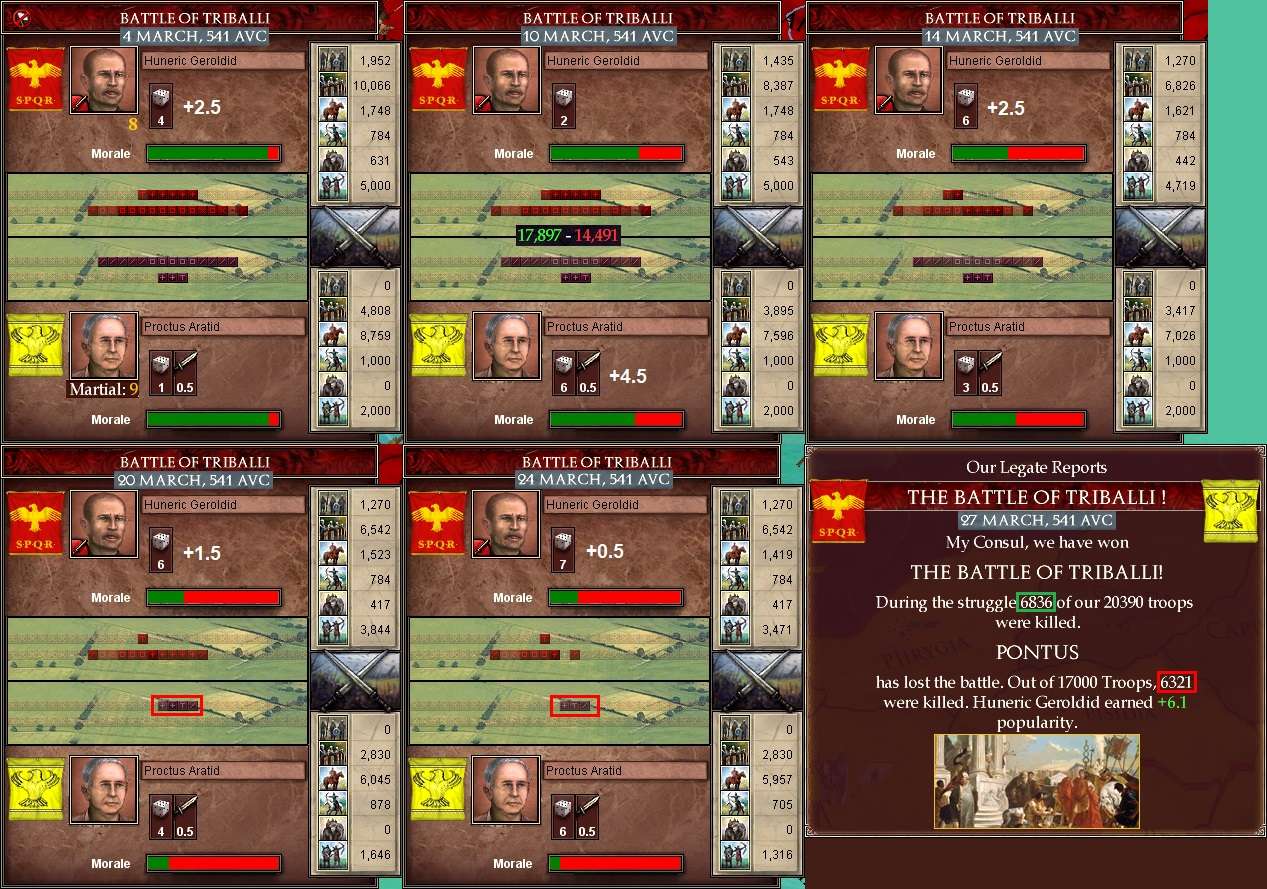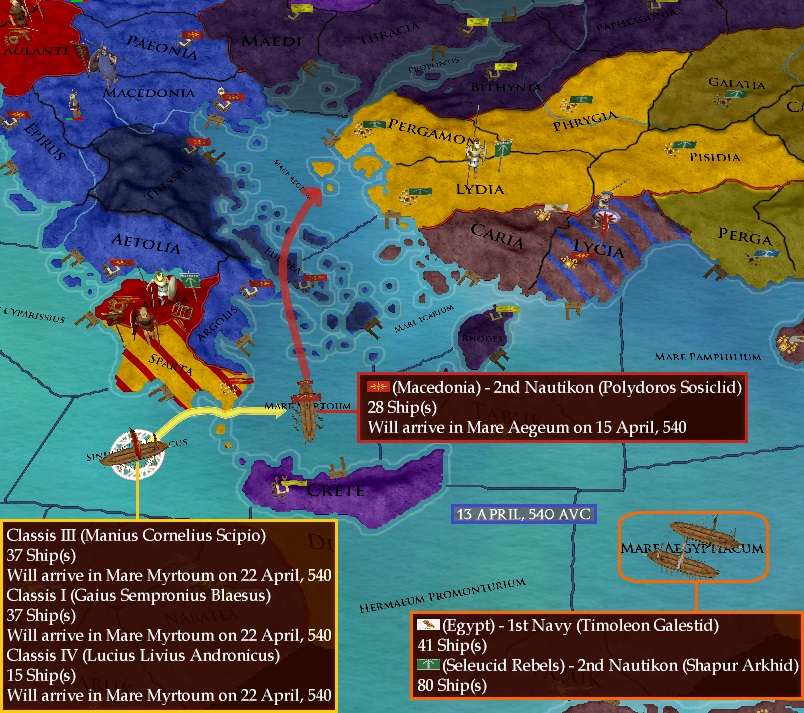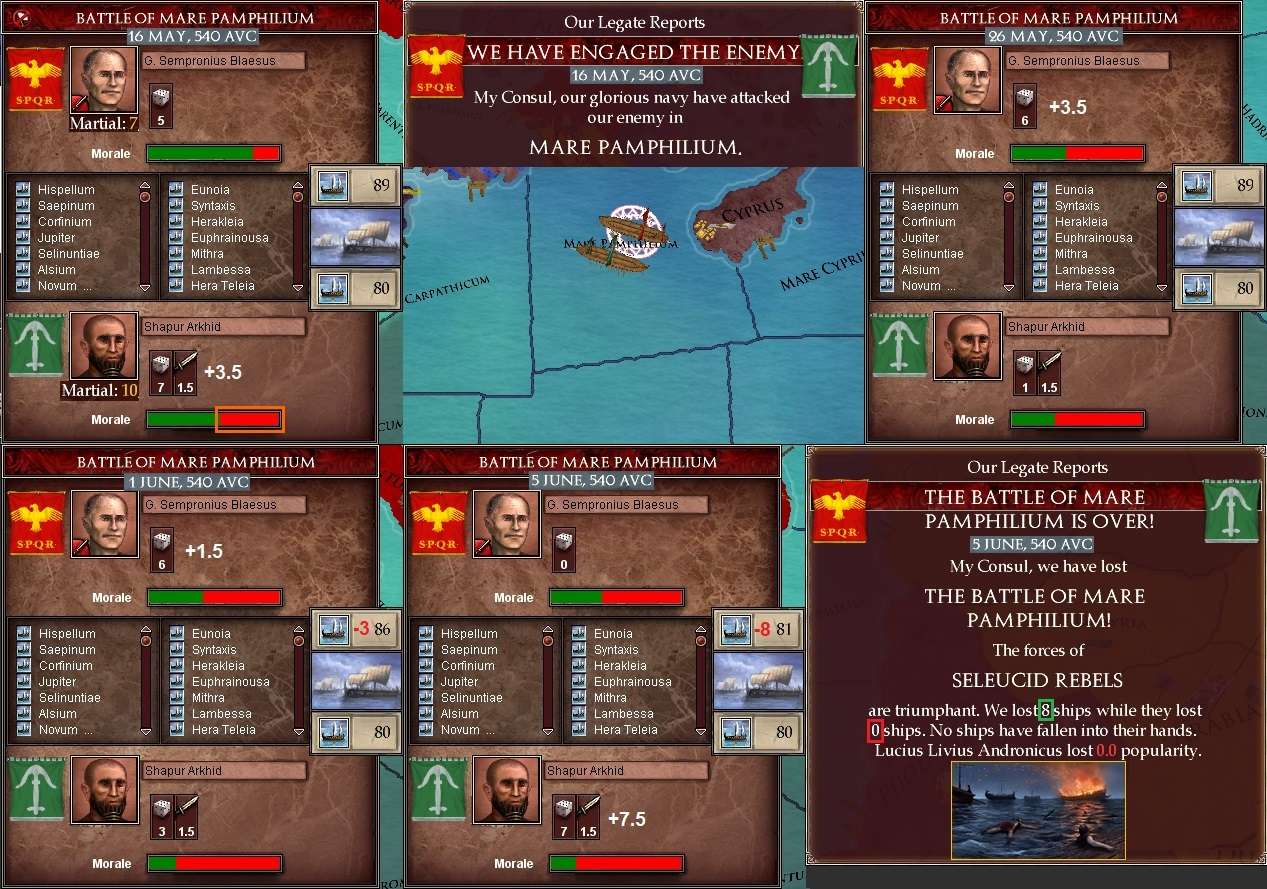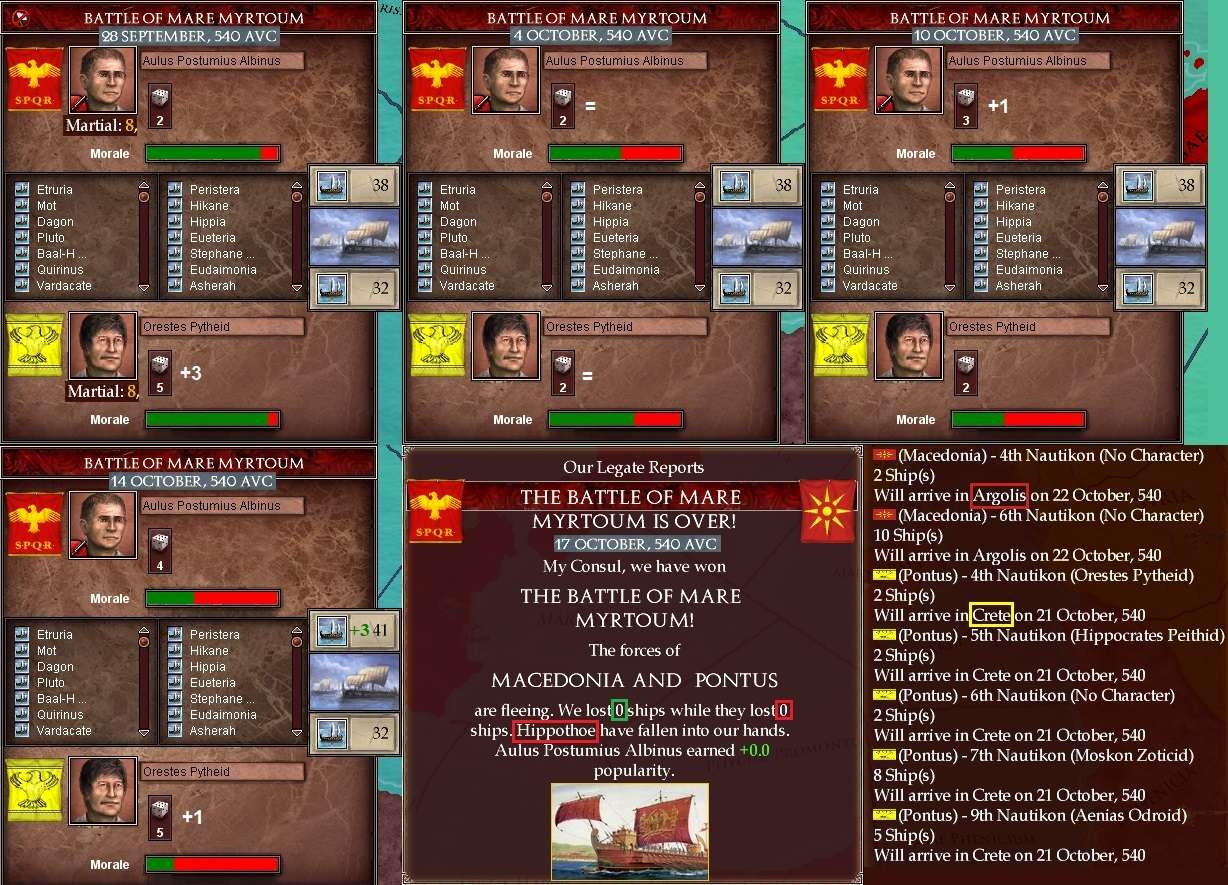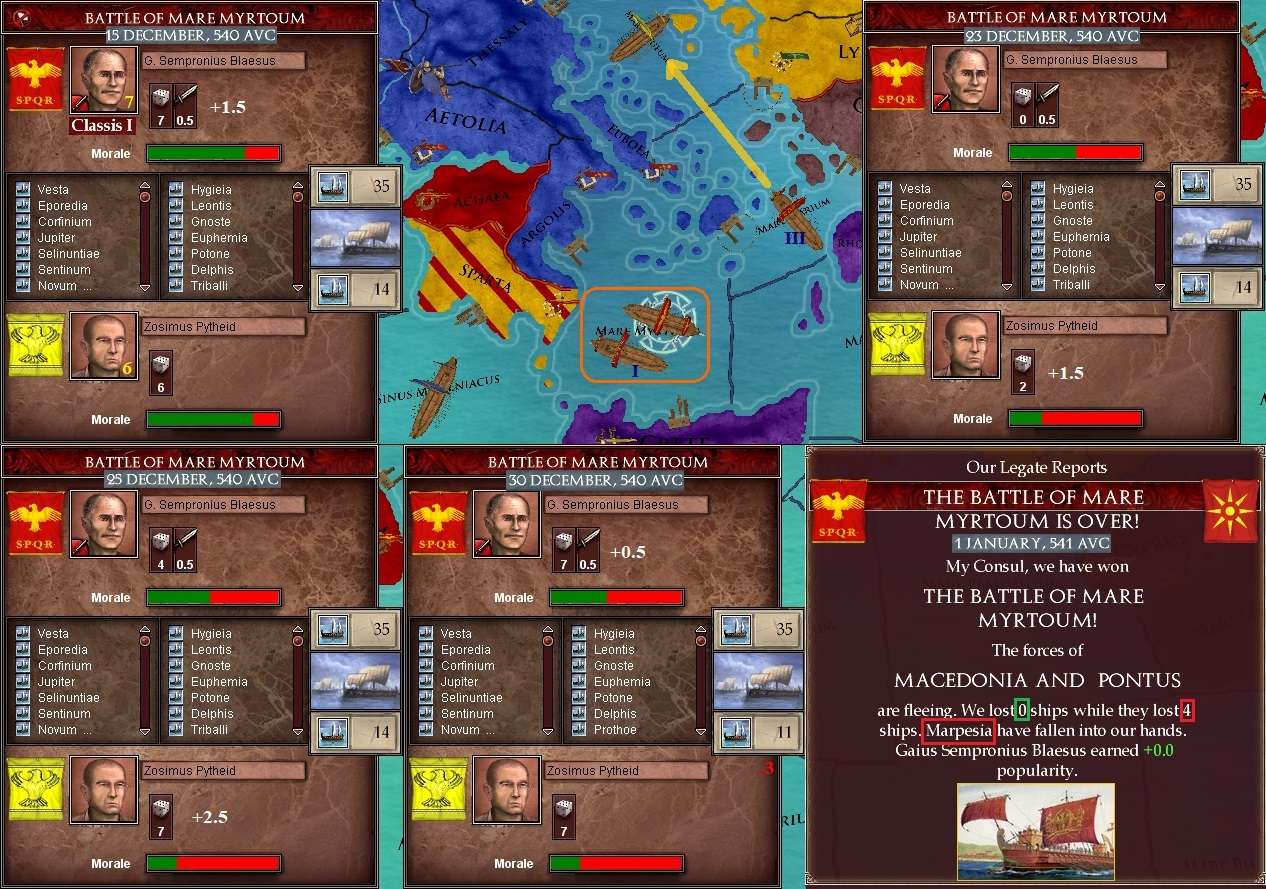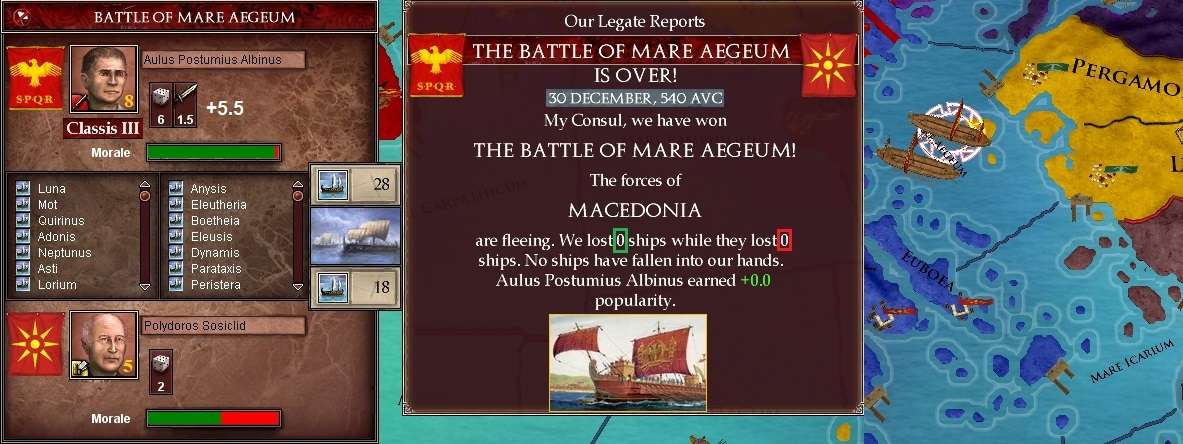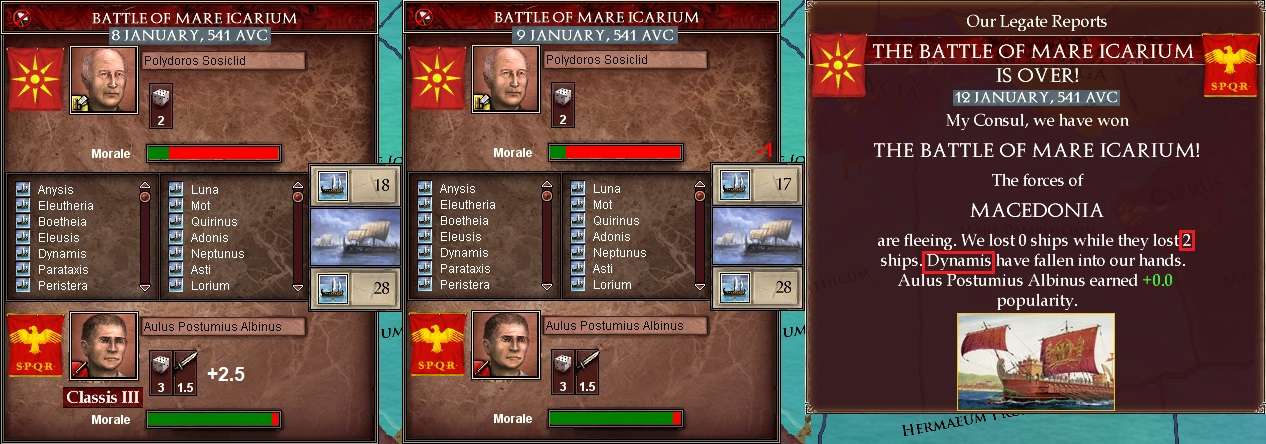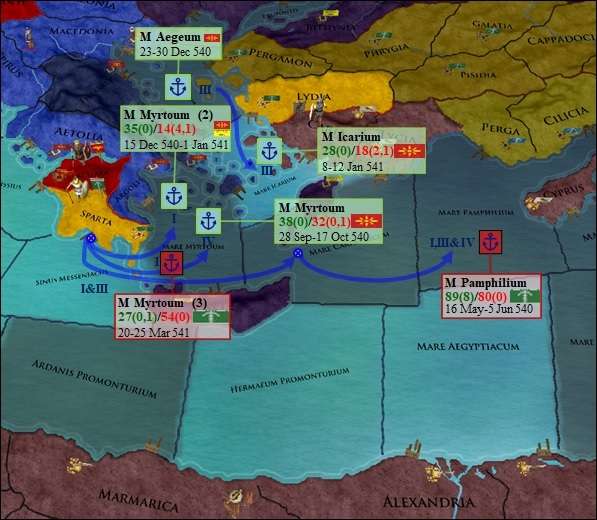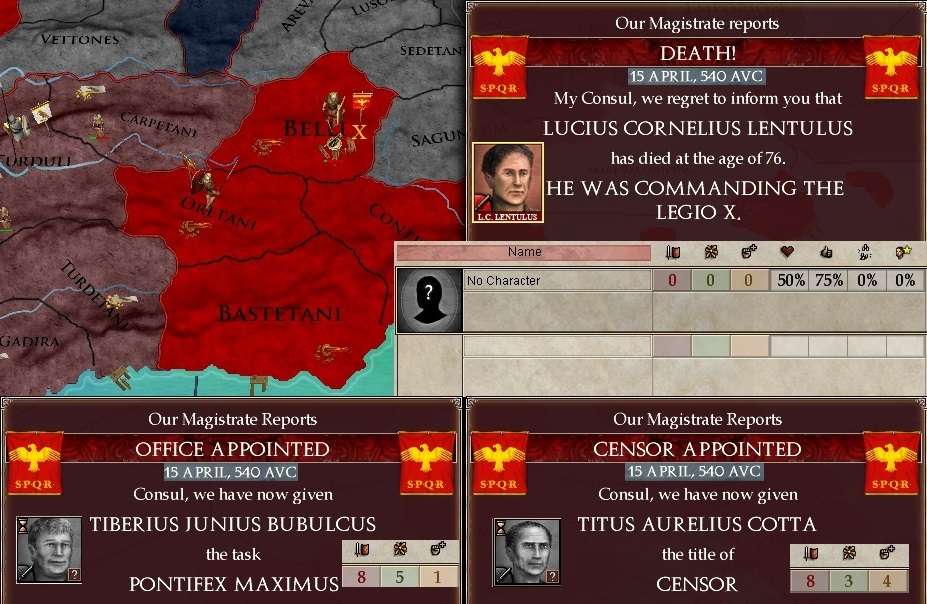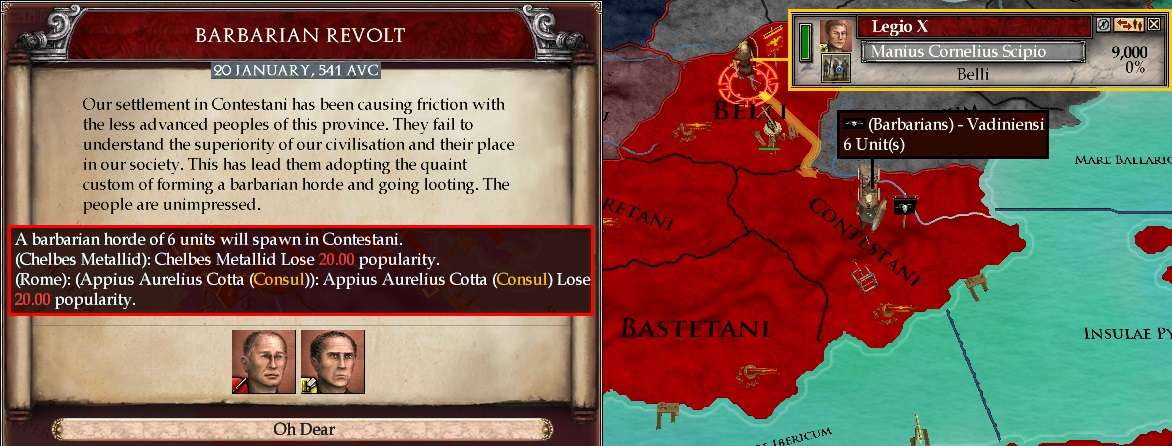Chapter LXXVII: The East is Red
(26 February 540/214BC to 30 March 541/213BC)
Foreword. We are fortunate that the main Roman commanders of the Great Eastern War – Generals and Admirals – kept journals as detailed as any from the period and
[like Julius Caesar in OTL] that they were all preserved for the historical record. The challenge in this abridged history is to reduce the wealth of detail available into a shorter account.
This first instalment covers the first year of the largest, most complex and bloodiest war in Roman history to that point. The chapter is divided into three parts, dealing with the war on land, at sea, and events in other areas. The land and naval war chapters include a broad summary of major Roman troop movements and battles for the period, which are not intended to be comprehensive accounts of
all Roman or enemy movements.
§§§§§§§
1. The War in the East - Land Campaign
February-March 540
The dusty and exhausted messenger Aulus Claudius Caudex, the Roman Commander-in-Chief in Illyria and Graecia, had seen riding into his camp in
Taulanti rushed straight to him. Caudex was not surprised to see the contents of the scroll as he cracked the seal Humphronius had applied to it back in
Roma when Consul Marcus Cornelius Scipio had made his decision.
In the end, with no
casus belli left against Macedon and none against Pontus either, Rome opted to strike at the head of the snake first. M.C. Maximus delivered the declaration of war on the Seleucid Empire – who would have soon joined in any war on Macedon anyway. To the relief of Rome, both Egypt and Massilia immediately responded with their own declarations in support of Rome. The Great War in the East had begun.
The Grand Fleet left harbour in
Achaea with 73 ships, comprising Classis I (G.S. Blaesus, 36 ships) and III (Consul M.C. Scipio, 37 ships). With 202 out of 204 possible cohorts fielded, one each of regular
principes and
velites were put in training in
Agrianes and
Scodra, and two more ships commenced. The naval campaign will be described in a separate section.
The first land move on 26 February 540 was for Legio VIII (T.F. Gurges
[Martial 8], 45 cohorts) to march south from
Achaea against the Seleucids in
Sparta. The 21 regiments of the Seleucid 2nd Stratos tried to escape east to
Argolis, but they would be caught by Gurges before they could get away.
Then just a few days after the war began, an amazing event occurred: on 1 March, a great civil war broke out in the Seleucid Empire – dividing it almost exactly in half. The Grand Alliance of Rome, Egypt and Massilia was now at war with both Seleucid regimes, even as they fought amongst themselves.
Macedon joined the war the same day – and would cooperate with both Seleucid regimes against the Grand Alliance.
Sparta and its 2nd Stratos had gone with the Seleucid Rebels. Legio I (A.C. Caudex
[Martial 9], 27 cohorts) marched to attack the small Macedonian army in
Epirus and Legio VI (Q.M. Vitulus
[Martial 8]), still under strength from it battles against the barbarians with around 17,300 men, headed for unoccupied
Dardania.
The Eastern Pact was completed on 2 March when Pontus joined the war. This was the signal for Legio II H. Geroldid
[Martial 8], 23 cohorts) in
Daci and Legio V (Q.F. Flaccus
[Martial 7], 22 cohorts) in
Moesi to march against the Pontic army in
Suci.
Egypt’s initial moves saw their 6th Army (21 regiments) march north from
Caria to Seleucid Rebel
Lydia, while the 7th Army (also 21 regiments) headed for rebel-held
Arabia from
Nabatea. Their 3rd Army (34 regiments) in
Carthage began marching east through Roman territory (this would take them a
long time), while 22 regiments in Egyptian
Corniclalum also began a somewhat shorter march to the east. Massilia had assembled their 1st Stratos (12 regiments) and it was marching east from
Massilia.
By 11 March, just before the first battle began, Roman manpower reserves remained at their maximum of 120,000 men, with around 1,000 being trained each month.
More good new came on 15 March: the Rhoxolani had seized this once in a generation opportunity to take on their old foes under fairly favourable circumstances. The war was spreading. Pontus and Macedon remained at war with Parthia, that the Seleucids had quit recently.
Gurges’ Legio VIII attacked Sosicles Arkhid
[Martial 7] in
Sparta on 15 March. He won comfortably in a week, even though he had a disastrous start to the battle
[Rome 0+0.5 v 6 Seleucid Rebel die roll], taking 3,803 casualties against 1,248 for the Rebels before they made a tactical withdrawal north to Roman
Achaea on 22 March. Gurges immediately used his great numbers (now just over 41,000) to begin an assault on the 2,000-strong Spartan garrison.
That same day, the Rebel 6th Stratos hit the Egyptian 6th Army in
Lydia and the Macedonian 1st Stratos (27 regiments) appeared to their east, in
Phydia and heading towards Egyptian
Lycia. At least one of the ‘missing’ Macedonian armies had been located.
Gurges finished won his assault on 31 March, losing around 700 men and much morale, and chased the Rebels to
Achaea, about ten days behind.
§§§§§§§
April 540
Meanwhile, Legio V had been first to arrive in
Suci on 30 March, beginning the Roman attack on the Pontic 1st Stratos on, which fielded 28 regiments and had a top-rate commander: Sophronius Zagreid
[Martial 9]. But the veteran Flaccus held his ground well enough
[Rome 7 v Pontus 3+1, then 1 v 3+1] until 8 April, when Geroldid arrived with Legio II to turn the tables
[5 v 1+0.5]. The Romans won on 12 April, losing 7,788 of their 45,000 men, the Pontic force losing 7,603 of their 28,000. Legio V stayed to recover and besiege
Suci, while Legio II (which took only just over 600 casualties) chased 1st Stratos to
Triballi.
Legio XI (D.C. Scipio
[Martial 7], nine cohorts) confronted the invading Rauraci barbarian war band in
Ditiones on 2 April, competently seeing them off by 12 April (385 Roman casualties out of 8,925 against 2,414 of the 6,560 barbarians). They would have to guard against two more attacks yet from the persistent tribe.
Gurges caught up with the Rebels in
Achaea on 17 April, but was initially blind-sided
[1+0.5 v 6] before asserting his superiority in skill and numbers five days later
[7+0.5 v5]. In another bloody fight, Legio VIII emerged victorious on 27 April, losing 4,667 of their 39,750, Arkhid’s Rebels 6,065 of 18,702.
On 23 April, the Macedonian 3rd Stratos (38 regiments) had been sighted in
Maedi, making for
Macedonia. Legio I now moved to intercept them from
Taulanti. Legio VI arrived in
Dardania to the north of
Macedonia the same day. By then, in Anatolia Egypt was fighting the Seleucid rebels in
Caria, while the Macedonians had assaulted and taken
Lydia and were advancing on them from the east: things looked difficult there for Rome’s major ally.
Better news came the next day, with another old enemy of the Seleucids declaring war on them.
A day after the victory in Achaea, Caudex’s Legio I with a full 27,000 men clashed with Macedonia’s smaller army of 10,000 men that had been fleeing Epirus in
Macedonia. Their hapless commander Phidias Xenonid
[Martial 4] was hopelessly outmatched by Rome’s top general
and outnumbered. He was then ambushed on the battlefield
[5+2.5 v 1]. It was a slaughter: all 10,000 Macedonian troops were killed by 1 May for the loss of only 62 legionaries – a stunning victory.
§§§§§§§
May 540
After the first few months of the war, and despite some attrition on top of the battle casualties, Roman manpower was at 118,000, with 17,687 needed to reinforce the legions.
On 13 May, Gurges once again met the Seleucid Rebels, having chased them back south to
Sparta (now Roman-occupied). Sosiclid Arkhid’s men offered little resistance, wiped out in a day losing their remaining 10,537 soldiers for only 436 lost in Legio VIII. The next day Gurges marched his surviving 34,500 men north towards
Thessaly – attrition was taking its toll the longer the war went.
In
Arabia, 18 May saw the Egyptian 7th Army (21 regiments) now trying to retreat back to home territory, but it would not escape a large Rebel army (27 regiments) coming at them from the north-west.
Geroldid’s Legio II went in against Zagreid’s 1st Stratos in
Triballi on 21 May, with better morale and slightly higher numbers. The Pontic army’s advantage was in cavalry and horse archers, the Romans’ (as usual) in heavy infantry. Geroldid largely held his own, but in winning suffered heavier casualties, while the ‘morale margin’ kept eroding in a tense victory in a gruelling twenty-day battle.
While the battle in
Triballi was at its height, the Macedonian 3rd Stratos, whose 38 regiments mustered 32,300 men against the 26,938 of Legio I, attacked Caudex in
Macedonia on 29 May. Unfortunately for the Macedonians, their commanders were not up to Pontic standard: Omiros Proctid
[Martial 3] was no match for Caudex. He started poorly
[Rome 2+3 v 0] and though he recovered somewhat
[4+3 v 6] after that, by 9 June it was another heavy Macedonian defeat – especially for a country without the manpower reserves of its Pact allies or Roman opponents. Rome lost 2,905, the Macedonians 11,414.
§§§§§§§
June-July 540
By 5 June, Egypt had lost
Caria to the Rebels: their 7th Army was sheltering in
Lydia,
Caria and
Lycia were both under enemy occupation and their 7th Army in
Arabia had been attacked by a larger rebel army. And their reinforcements from the west weren’t even in
Libya yet.
The Rauraci returned to
Ditiones on 9 June, with around 4,000 warriors left against almost 10,000 legionaries (Legio XI had received a cohort of reinforcements since April). But this time they attacked furiously
[Rome 0+1.5 v 7] for the first five days until Scipio returned the favour
[6+1.5 v 1]. The Rauraci fled before they could be wiped out: they lost 2,165 men, but this time took 1,354 Romans with them.
Having won their hard fight in
Triballi, on 10 June Legio II pursued the Pontic 1st Stratos to
Crobobizi, hoping to maintain the initiative. Manpower reserves stood at 116,000 but 27,411 men were now needed for the legions as casualties mounted. There was bad news from the Egyptians on 20 June: 7th Army had been defeated in
Arabia and were being pursued to
Nabatia.
Geroldid and Zagreid continued their deadly rivalry in
Crobobizi on 7 July. 14,995 Romans faced 15,232 Pontic soldiers. But Roman morale was wearing thin and they found themselves attacking over a river and Zagreid made a spirited start
[Rome 3-1 v 7+0.5]. Geroldid knew his gamble had failed and he faced a losing battle, retreating back to the hoped safety of Legio V in
Suci as soon as he could on 11 July. He had already lost 2,863 men against only 369 for Pontus.
Two days later, Legio VIII was in
Thessaly and heading west to
Epirus, where the Macedonian 3rd Stratos lurked after their defeat by Legio I, while Roman sieges in
Paeonia and
Macedonia continued. 3rd Stratos headed south to
Aetolia as soon as they learned Gurges was coming: they were due to leave the day Gurges arrived. It would be a close call to see if they were caught or escaped.
In a surprising twist, on 15 July the Egyptian 6th Army (21 regiments) was attacking the Macedonian 1st Stratos in
Lycia: perhaps the latter were under-strength due to manpower shortages?
§§§§§§§
Consular Election of 540
The news of the Great war in the East and other barbarian travails elsewhere did not halt the Roman election cycle, even if it occupied the focus of all. It brought an old soldier to power – once a leading commander, though his skills had been surpassed by the new generation of Legates that had arisen in recent years.
A.A. Cotta extended the rule of the Mercantile faction for another term and, while his sceptical ways might suppress research, his solid military credentials should keep the war effort on an even keel. The next contenders at that early stage showed a comeback by the religious-military complex may be in the offing next term.
Other than war reporting from the front, Humphronius reminded Cotta that three colonisation options were available – in
Vindelicia,
Maezaei and
Breuci.
“Thank you, Humphronius, but the East is red with blood. In light of extant barbarian threats in Illyria and the focus on the war, we will defer these opportunities for now. But they are not forgotten.”
“Yes, Consul.”
§§§§§§§
August-September 540
The Consul also had a close eye on the manpower situation as the cost of the war and defending the Republic mounted. On 1 August manpower was steady at 116,000 men, but now almost 41,000 vacancies existed in all Roman legions – throughput of replacements for battle casualties and attrition for legions in enemy territory was the main problem.
By 9 August siege work was progressing slowly against strong Macedonian resistance, with most progress in
Suci [50%], then
Macedonia [38%] and nothing to show so far in
Paeonia [0%]. Macedon had stragglers besieging
Taulanti and
Moesi [both 0%], but neither was of current concern.
The Rauraci were finally despatched in
Ditiones between 13-19 August, Scipio’s Legio XI only losing another 33 men in the process. 1.04 gold and 9,000 slaves were taken. The next day they marched east to
Moesi to join the main war effort, now with 11 cohorts and almost at full strength.
Legio II finished its retreat to
Suci, joining Legio V on 17 August, but subject to attrition due to the number of cohorts (45) present, even though both legions only mustered just under 25,000 men between them.
The next day Legio VIII arrived in
Epirus to find 1,000 Macedonian recruits just finishing training – all 1,000 were wiped out that day. They had just missed the main Macedonian force led by the now elusive Omirus Proctid – who had escaped to
Aetolia. Gurges gave chase south. This led to a period of marches and counter marches in central Graecia, between Legio VIII in
Epirus and Proctid in
Aetolia on Thessaly. Legio I remained in
Macedonia – where Caudex was determined to hold on and complete the protracted siege.
With the effusion of blood in the east, the Blessing of Cupid was successfully invoked for the annual omen.
The relative lull in the Graecia campaign continued through to the end of September. The Romans had eventually allowed the Macedonian 3rd Stratos to move up to
Thessaly, where they arrived on 30 September. The siege in
Macedonia was half complete by then, so Legio I remained fixed, with Pontic troops still lurking in nearby
Maedi to be deterred. 3rd Stratos advanced on
Macedonia, while Legio VIII moved to reinforce Caudex with 25,000 men, leaving behind a small detachment in
Epirus to maintain the siege there
[still 0%].
§§§§§§§
October 540
On 4 October, 3rd Stratos halted, as did Legio VIII, instead marching north to relieve
Taulanti. Rome also received an embassy that day from the Seleucid Rebels offering peace – but the terms were insulting. They wanted Rome to pay 250 gold talents in reparations. The Romans were so incensed that Davidus Brentatius Officialis was sent to deliver the reply to the rebel ambassador:
“Quitters never win, winners never quit,” he told a rather bemused Zenodoros Sosiclid. “But those who never win and never quit are idiots.”
Sosiclid assumed this was a rejection and returned empty handed.
The siege in Pontic
Suci was won on 21 October after 191 days. Manpower was at 114,000 and now over 44,000 replacements were needed. And a large Pontic army was approaching from
Triballi. This triggered the beginning of a process that would persist as the war dragged on: cohorts were consolidated in both Legio II and V, combining like elements to form whole cohorts where possible. They were then redistributed and consolidated again.
Once this was done, the equivalent of at least 17 cohorts had been disbanded
[down to 188 cohorts out of a starting TSL of 205]. New recruiting was then initiated in Illyria: regular troops drawn from Roman manpower (cohorts of horse archers, cavalry and two of
principes). This left manpower reserves at 110,000, but only 16,169 men now required to replenish the reduced cohort numbers. The bulk of the forces in
Suci were concentrated in Legio II under Geroldid, while Flaccus took the collection of under-strength cohorts to Dardania, to chase out Macedonian stragglers and try to recover. In Thessaly, the 3rd Stratos was advancing on Macedonia again, while Legio VIII halted in
Epirus and waited for events to develop.
Two days later, the Pontic 1st Stratos diverted to
Dardania instead of maintaining their advance on
Suci. Legio V stopped their own move and headed west to the presumed safety of
Moesi instead, where Legio XI arrived from the west on 29 October. That seemed to persuade Pontus to change plans again, Zagreid taking 31 regiments north to
Crobobzi instead. Legio XI was ordered to fill the vacuum, heading south to occupy
Dardania and hopefully reduce its fortifications.
§§§§§§§
November-December 540
The Massilian 1st Stratos (12 regiments) was in
Dalmatae by 9 November and heading to
Scodra. This was very useful, as a smaller Macedonian contingent was heading there from
Dardania. The Macedonian 3rd Stratos was once again halted in
Thessaly. Legio V was recovering in
Moesi by 19 November (1,999 men in six cohorts). And on 20 November, the 65 year old ex-Consul Manius Junius Bubulcus – militarily hopeless
[0] but immensely charismatic
[10] – died from an old wound. He had been serving out his last years as the Governor of Aquitania. But more significantly for the war,
Macedonia fell that day after almost seven months of siege.
This fulfilled the existing Senate mission and gave a renewed core claim on
Macedonia, but gave rise to a new – and rather improbable – one.
By 21 November Egypt had recovered in Anatolia:
Caria had been retaken and they had one army attempting to break the siege on
Lycia, while another invested
Lydia.
With
Macedonia subdued, it was time to pursue the main Macedonian in
Thessaly: Legio I and VIII moved in tandem – and the Macedonians were soon scurrying south.
In
Roma, Humphronius present Consul Cotta with a summary on the current state of the Great War in the East. Both the Seleucid regimes retained large manpower reserves, as did Pontus and Rome’s ally Egypt. All of them remained far ahead of Rome in technology, though all bar Macedon were short of money. Macedon had an abundance of riches but no men in reserve (a problem they had wrestled with for years).
The Great War with the Eastern Pact was proceeding modestly in the Grand Alliance’s favour, but the others showed only slight progress.
Legio XI arrived in
Dardania on 29 November, with the formidable Zagreid bringing a reduced 1st Stratos (11 regiments of unknown strength) their way, due on 12 January in the new year.
As winter intensified, in early December more consolidation had seen the number of Roman cohorts reduced further to 177, manpower at 109,000 and 15,407 men needed for the reduced order of battle.
Legio I was first to arrive in
Thessaly on 21 December, by which time the 3rd Stratos had made it to
Aetolia. Caudex continued to pursue them. Legio VIII switched their move to
Aetolia to complement Legio I’s advance, while the 3rd Stratos withdrew south again to
Achaea – they led the Romans a merry chase, but could not run forever. The same day, the Massilians performed a useful service by switching their advance to
Taulanti, where three Macedonian regiments in the 2nd Stratos was laying siege. The Massilians would get there three days before the Macedonians could escape.
Then on 27 December, the Macedonian 1st Stratos (29 regiments) combined in
Maedi with a Pontic Army (2nd Stratos, 22 regiments) commanded by the ruler of Pontus, Basileus Mithridates Mithridatid, to advance on Legio VI (Q.M. Vitulus, 16,827 men) in
Paeonia. He reluctantly broke his siege and marched north to join Legio XI in
Dardania.
§§§§§§§
January 541
The Macedonians arrived in Roman
Achaea on 10 January and (perhaps unwisely) assaulted the 2,000 strong garrison with 39 regiments of around 20,000 troops, over 9,000 of whom were cavalry or horse archers and thus unable to take part in the storming. The assault continued on 13 January, the day Legio I arrived in
Aetolia and kept marching south. The 3rd Stratos did not give up until 17 December, when they broke off and tried to flee east to
Argolis. But they had overstayed: Legio I would strike them in
Achaea before they could leave.
On 11 January, the joint Macedonian-Pontic force hit Q.M. Vitulus’ Legio VI in Paeonia, before had had completed his escape. Basileus Mithridates
[Martial 7] took command of the enemy force, which also had to attack across a river obstacle. After an five days of fighting
[Rome 4+0.5 v 5-1], Vitulus withdrew in good order as he was hugely outnumbered, leaving the field to the enemy but claiming a tactical victory, losing 1,667 of his 16,071 men, while the Pact army lost 2,261 of the 37,342 men they fielded.
The Massilians had ambushed the small Macedonian 2nd Stratos in
Taulanti on 12 January, where they were victorious after a few days. 25 January saw Legio VIII make it to
Aetolia: instead of following Legio I to
Achaea, they marched south-east to
Argolis, to cut off the elusive Macedonian 3rd Stratos once and for all. The latter halted in
Achaea the next day – resigned to their fate and hoping to fight just one Roman legion at a time.
§§§§§§§
February 541
That fate in
Achaea arrived on 2 February. On the northern side of the battlefield, Caudex arrayed Legio I’s 19,478 men for battle. The ineffective Omirus Proctid had 17,782 men. And though badly outclassed he started bravely
[Rome 3+3 v 7], but then Caudex took the upper hand
[4+3 v 2]. Proctid rallied
[3+3 v 6] but was heavily beaten by 21 February, losing 9,940 men to 2,416 Romans killed.
Meanwhile, the main Pact army in central Graecia had left
Paeonia and made straight for the capital of
Macedonia, where they arrived on 8 February. With the Roman garrison only built up to 400 men at that stage, the walls were stormed and the city after four days of resistance. At that point (11 February 541), no Macedonian province was under Roman control. Their job done, the 27 regiment Macedonian 1st Stratos headed back north to
Paeonia, but the Pontic 2nd Stratos (22 regiments) stayed where they were.
In
Dardania, Legio VI consolidated with Legio XI, Vitulus taking 20 cohorts (18,986 troops) south to meet the Macedonians in
Paeonia the same day
Macedonia fell. The five remaining under strength cohorts stayed manning the siege in
Dardania under Legio XI.
With the Macedonians still fighting but looking decisively defeated in
Achaea, Legio VII was no longer required in the south: on 12 February they began marching back north to
Thessaly.
The march of Legio VI on
Paeonia scared off the Macedonian 1st Stratos under Aminias Sosiclid, who changed directed, making for
Taulanti on 19 February. Legio VIII likewise changed tack, heading for
Epirus instead.
The Massilian 1st Stratos arrived first in Paeonia on 23 February. They began a short assault, but it was called off after a couple of days.
§§§§§§§
March 541
As March began, Roman manpower stood at 106,000 with 22,738 replacements needed – despite all the unit consolidation that had been taking place. This was not about to improve any time soon, with another major battle breaking out on 4 March.
Spotting an opportunity, Geroldid had taken Legio II to attack the Pontic forces under a new commander in
Triballi. Of course, true to Pontic standards, Proctus Aratid proved to be another great general
[Martial 9]. Geroldid had about 3,000 more men and an advantage in heavy infantry and archers, Pontus again a cavalry-heavy force. Geroldid did well to gain the initial upper hand, but Aratid fought back fiercely from 9-14 March. The battle remained close and tensely fought affair, but the seasoned Geroldid managed to keep a narrow tactical advantage. He won the battle after 23 days of fighting on 27 March, though he had suffered more casualties than the enemy, which were heavy on both sides.
While the desperate fighting continued in
Triballi, Legio VI joined the Massilians in
Paeonia – who immediately initiated another assault! Vitulus was
[literally] given no choice but to join in, but the 1,163 enemy garrison was overwhelmed by the combined Grand Alliance force on 10 March.
Caudex caught up with Proctid in
Argolis on 17 March for a final reckoning. Legio I had 19,420 troops in good condition; the 3rd Stratos had only 7,292 men left from its once mighty force – and they were badly demoralised. They ceased to exist as a formation on 20 March, Caudex only losing 13 men wiping another enemy army off the map. He left a detachment of around 2,500 men there to begin a siege, taking the rest back north to
Thessaly.
On 18 March, around 13,000 Macedonia troops were in
Taulanti, once again putting under siege. Legio VIII arrived in
Epirus [where the siege was now at 100% progress] and kept going on to
Taulanti, aiming to relieve it with his 22,600 legionaries.
After his hard win in tribally, Geroldid decided not to repeat his earlier mistake: Legio II was weakened and exposed in
Triballi, so he headed back to recover and defend
Suci. Manpower reserves held at 106,000, with 23,609 replacements needed.
A summary of key battles, sieges and Roman movements from the start of the Great Eastern War on on 26 February 540 to the end of March 541 AUC.
§§§§§§§
2. The Naval Campaign
February-July 540
Classis I and III had sailed from
Achaea as soon as the war broke out on 26 February. By mid-March they were blockading
Sparta with 74 ships between them, while Classis IV was in
Mare Siculum on its way to join them with another 15. Egypt had a fleet of 41 ships heading back to port in
Sinai, while the Seleucid Rebels had a single fleet of 80 ships heading west towards
Mare Carpathicum (north-east of
Crete). The rest (bulk) of the Egyptian fleet seemed to be in Hispania. On land, Legio VIII was at that point attacking
Sparta.
By 13 April, the Rebels and the badly outnumbered Egyptian fleet were doing battle in
Mare Aegyptum. The Roman Grand Fleet had fully assembled and was sailing to
Mare Mytoum, where they would miss a smaller Macedonian fleet by a week.
Sparta was by then securely under Roman occupation.
On 24 April, the Grand Fleet had reached
Mare Myrtoum and made the fateful decision to proceed to either aid the Egyptian fleet battling the Seleucid Rebels in
Mare Aegyptum, or alternatively to take advantage of what it was hoped would be their battle damage if they had beaten the Egyptians (who they outnumbered by about 2-1) by then.
On 3 May, things were going badly for the Egyptians, who had lost 18 of their 40 ships – the Rebels losing none of their 80. But the Romans sailed on bravely. On 12 May they were in
Mare Icarium, while the Rebels had defeated the Egyptians and begun sailing back to port, probably to
Perga on the Anatolian coast. The Romans would try to catch them before they reached the safety of port.
On 16 May 540, the largest known naval battle in history to that date began in
Mare Pamphilium, off Cyprus. The Romans outnumbered the rebels with 89 ships against 80. G.S. Blaesus commanded the Grand fleet. The rebels were indeed worn out by the fight with the Egyptians – but their commander Shapur Arkhis was a naval genius
[Martial 10]. And despite a competent initial disposition by Blaesus, Arkhid deployed his ships perfectly. The first five days of the battle evened up the score significantly. But Blaesus struck back on 26 May, comprehensively outmanoeuvring his more skilled opponent.
Despite maintaining a tactical edge on 1 June and failing rebel morale, the Romans had begun to lose ships; three by 1 June, five more by 5 June; the Rebels had lost none. Then on 5 June, disaster struck: the God’s
[Fortuna, the RNG deity in particular] forsook the Romans. Blaesus called a withdrawal without a moment’s hesitation – thus rescuing his ships from outright catastrophe. They would think very hard before tackling the Rebel navy again: it was now a matter of returning to Sparta for much-needed repairs.
Two ships had been laid down when the war started. With the losses in
Mare Pamphilium, two more were ordered on 9 June.
The Grand Fleet extracted a measure of revenge when they caught small Macedonian flotilla in
Mare Carpathicum on the return to
Sparta, destroying all four galleys for no loss on a single day on 15 June.
They were safely back in
Sparta on 10 July. First, the ships were redistributed into a ‘ready’ fleet (Classis IV at that point) with 27 ships at between 96-100% strength. The old but efficient Aulus Postumius Albinus
[Martial 8] was retired as Censor and, now qualified for command, put in charge of that fleet. Classis III (26 ships at 60-95% strength) would be the next available, while Classis I (Blaesus, the 28 ships most badly damaged ships) also went to the dockyards. This process of rotating ships through for repair while the most seaworthy were ready for immediate targets of opportunity would persist for the duration of the naval campaign.
§§§§§§§
September-October 540
As it happened, the Roman Navy did not venture out again until mid-September, allowing most repairs to be thoroughly effected. On 15 September A.A. Albinus took Classis IV out with 38 full strength ships to intercept Macedonian and Pontic ships approaching from
Mare Myrtoum. He was fully deployed at sea in
Sinus Messeniacus four days later and making way towards the enemy – with the Pontic fleet trying to make for port in
Crete.
On meeting the enemy in Mare Myrtoum on 28 September and seeing they had 32 ships between them, another three almost-repaired ships left
Sparta to reinforce Classis IV on 28 September. It was hoped they could arrive in time to make a difference. The two commanding Admirals – Roman and Pontic - found themselves evenly matched in tactical prowess; but the Pact fleet (made up of seven different contingents) found the better winds in the opening days of the battle. This evened up on 4 October and thereafter both sides were evenly matched.
The three Roman reinforcements arrived on 14 October and by the 17th the Pact had had enough, the Romans having achieved a moral advantage and capturing one of the Macedonian ships as a prize. The Pact ships made for nearby home ports. The Romans would remain wary of any enemy fleets trying to sail past
Sparta, lest they escape to wreck trade or land ground forces behind the lines further west in Africa or Italia. For now, they concentrated back in
Sparta. With newly built ships arriving from Italia, the Roman Navy had 88 ships to hand.
Around this time, the question was asked: where was the rest of the vaunted large Egyptian fleet? It was discovered at anchor in
Turdetani, in Egypt’s Hispanian holdings, the 59 ships had apparently not left there since the war had started. It seemed the Roman Navy would need to do the ‘heavy lifting’ in the Eastern Mediterranean for the foreseeable future.
By 30 October, Albinus had command of the 28 most ready ships in Classis III and was off to chase eight Pontic ships sighted to the south and try to rescue a Massilian fleet of four ships that had tangled with them off
Alexandria.
§§§§§§§
November-December 540
On 8 November, another three ships were laid down in
Samnium,
Syracusae and
Liguria.
The Pontic fleet had escaped from
Hermaeum Promonorium before Albinus could catch them there: by 2 December he was pursuing them north. Meanwhile, another Pontic fleet had been spotted in
Mare Myrtoum: Blaesus took Classis I with 35 ships to intercept them from
Sparta.
On 12 December, Albinus found two Pontic triremes in
Mare Icarium and had sunk both of them by the next day, but the other six got away. Blaesus had better luck two days later, catching a mixed fleet of Macedonian and Pontic triremes in in
Mare Myrtoum. It was a fiercely fought battle, with the winds favouring one side then the other, Blaesus having a small tactical edge over his opponent. The Pact fleet had lost three ships by 30 December despite favourable winds for the previous five days, then the final fierce exchange from 30 December saw another Pact ship sunk and one captured, with the remainder fleeing on 1 January.
While that battle continued, Classis I pursued a sizeable Macedonian fleet in
Mare Aegeum and caught up with them on 23 December, fighting an inconclusive battle until the enemy broke away on 30 December.
January-March 541
Albinus caught up with the Macedonians a week later in
Mare Icarium, this time sinking two ships and capturing another before the Macedonians could escape again.
On 20 March, the Romans were out ‘hunting again’ when Blaesus and Classis I (27 ships) was caught in
Mare Myrtoum by a Pontic fleet double its size under the dreaded Shapur Arkhid. One Roman trireme was captured by the Pontic fleet before Blaesus could break away.
Major naval operations, March 540 to March 541.
§§§§§§§
3. Barbarians and Buildings
March 540 – December 540
On 1 March, the new Roman colony in
Belli (Hispania) was founded. The Lanciensi (the tribe Legio X had earlier defeated to help found the colony) warband had retreated to
Carpetani and were now bound for Egyptian
Turduli. The same day, new stockades were commenced in
Belli and in the relatively new Illyrian colony of
Liburni.
On 15 April came news that Legio X’s commander, the venerable and redoubtable former Consul L.C. Lentulus, had died. With no spare commander ready to allocate, T.J. Bubulcus was made Pontifex Maximus, replacing T.A. Cotta who was in turn promoted to Censor. But no appointment to Legio X was made as yet.
On 1 June, another revolt broke out in
Sequani. Legion III (12,000 men) responded from neighbouring
Arverni. It was commanded by M.C. Maximus
[Martial 3], an earlier Senate appointment
[better than nothing, but not much]. Justice was done between 28 July and 3 August, Maximus overcoming a strong rebel start and his inferior skills
[Rome 5 v 6+2] to wipe 2,165 of the 6,000 rebels out and dispersing the rest, though at the cost of 1,354 men.
Governors took the initiative on 14 August to build a new temple in
Vocontii and irrigation in the
Baleares, while on 2 September
Oretani in Hispania became a core Roman province.
A barbarian rebellion broke out in Belli, where the current commander M.C. Dentatus
[Martial 5], another Senate appointment to a vacant command, defeated 2,000 Coerlerni warriors from 7-14 October, killing 777 of them and losing 197 legionaries doing it.
Legio X got a new commander on 19 November when the Proconsul Manius Cornelius Scipio
[Martial 7], left his naval command (taken over by Albinus, as we saw previously) to command it. Dentatus had done alright, but a good general was wanted for this independent and usually quite busy assignment.
The Coerlerni returned and were beaten again in a single day on 27 December, Scipio losing only two men in killing the 1,203 who made it back, with 2,000 slaves taken into bondage.
§§§§§§§
January-March 541
20 January brought ill news from Hispania, with 6,000 barbarian rebels rising in
Contestani. Scipio was soon marching south-east to meet them.
The clash with the Vadiniensi came on 21 February. Despite a poor starting position, Scipio found himself up against a barbarian commander with no ability whatsoever
[Rome 0+3.5 v 1]. The barbarians ran off after five days, losing 2,442 men for only 27 Roman casualties. It once again demonstrated that good generals saved the lives of common soldiers.
§§§§§§§
Finis



